REMAKING A CLASSIC SPACE
By Katlean de Monchy–
The Southampton Arts Center hosted its seventh annual Architecture & Design Tour on Saturday, September 14, with this year’s theme, “Vintage/Reimagined,” spotlighting historic homes that had been updated for modern living.
THE PANEL DISCUSSION
Those who turned up for the tour of select Southampton properties were treated to a brunch followed by a discussion moderated by Brian Brady of Brady Design, which has offices in Southampton and Philadelphia. While known for its expertise in Classical architecture and Classical design, Brady Design obviously includes modern updates in its homes. The panelists were Pamela Glazer, a Southampton architect; Alvise Orsini, of Orsini Design on the Upper East Side of New York, who, incidentally, is married to Geoffroy van Raemdonck, the CEO of the Neiman Marcus Group; Quinn Pofahl, an interior designer based in Southampton, and the architect Lee Skolnick. These four shared their expertise on blending classic architecture with modern functionality.

The panel, moderated by Brian Brady, left: Lee Skolnik, Quinn Pofahl, Pamela Glazer, Alvise Orsini. (Photo by Rob Rich/SocietyAllure.com)
Each brought a different perspective on how they would add a modern accent to a traditional house. We’ve probably seen Quinn Pofahl’s windows and interiors of Ralph Lauren’s flagship store, the Gertrude Rhinelander Waldo House. You can’t get more traditional than that building, built in 1899 on the Southeast corner of 72nd and Madison, inspired by chateaux in the Rhine Valley. A conversion calmed down the rococo exterior, but still the window displays and the merchandise inside play against the more conservative shell. Pofahl’s house, on Hill Street, was on the tour. It is for sale, for nearly $7 million.

Quinn Pofahl (Photo Rob Rich/SocietyAllure.com)
Pamela Glazer did the interiors of two houses on the tour. Alvise Orsini contributed ideas, many gathered from his years of practice in Venice, Paris and London, on how to gracefully inject contemporary elegance into classic design.

Alvise Orsini (Photo Rob Rich/SocietyAllure.com)
And Lee Skolnick brought an architect’s eye to harmonizing contemporary needs to historic structures. Although it wasn’t on the tour, Skolnick described his process while turning an 1836 deconsecrated Methodist church in Sag Harbor into the welcoming arts center and artists residence we know it is today. He pointed out that, in total restoration work, there is a reason to make the work seamless. But on something historic, like the church, in his opinion, and as per the Department of the Interior, there is a tendency to let the rehabilitation “tell the story.”

Lee Skolnick (Photo Rob Rich/SocietyAllure.com)
In that case, with The Church, Eric Fischl and April Gornik’s gift to Sag Harbor, much of the Italianate and Greek Revival exterior remains the same, from the large stone foundation to the clapboard siding, and the belltower, with the original bell re-installed.
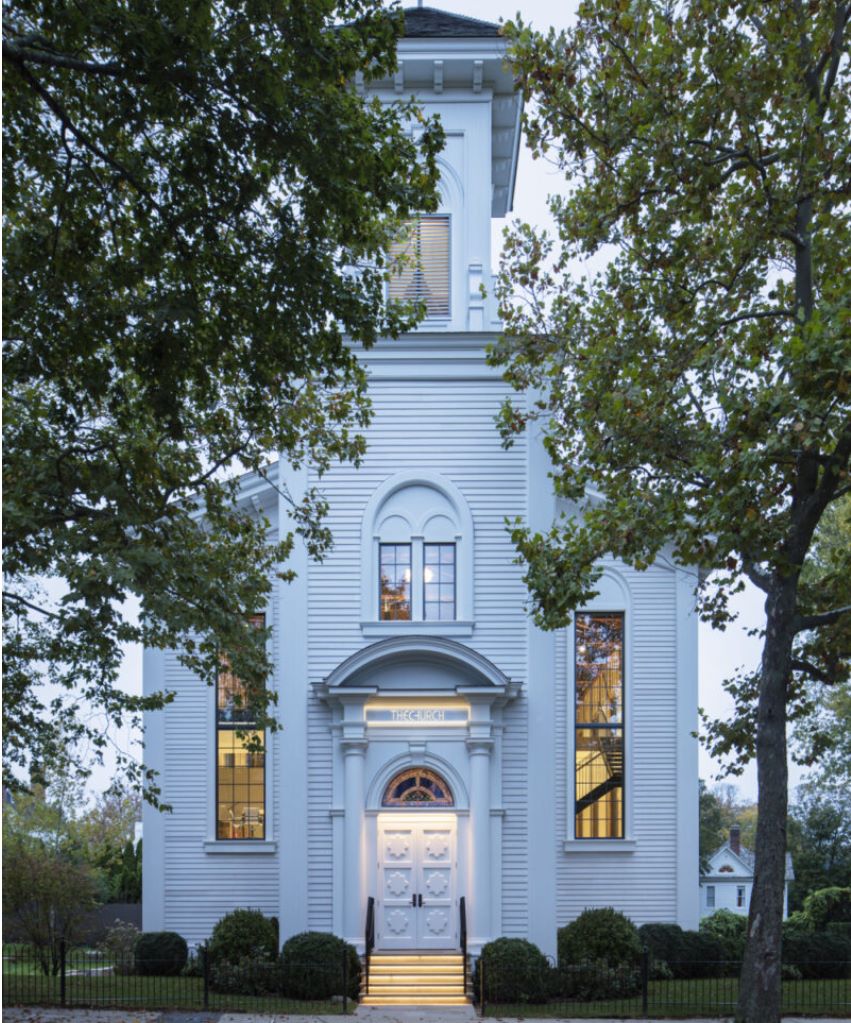
After renovation (Photo Scott Francis)
Inside, however, Skolnick said, “the interior was already gutted, so it didn’t have any of the original details worked with.” They stripped the building down to its wooden rafters and then opened the space to make three levels. Skolnick said, “Anything that was new was either white oak, gray steel, or white sheet rock. And so there’s a real clear distinction between old and new.”
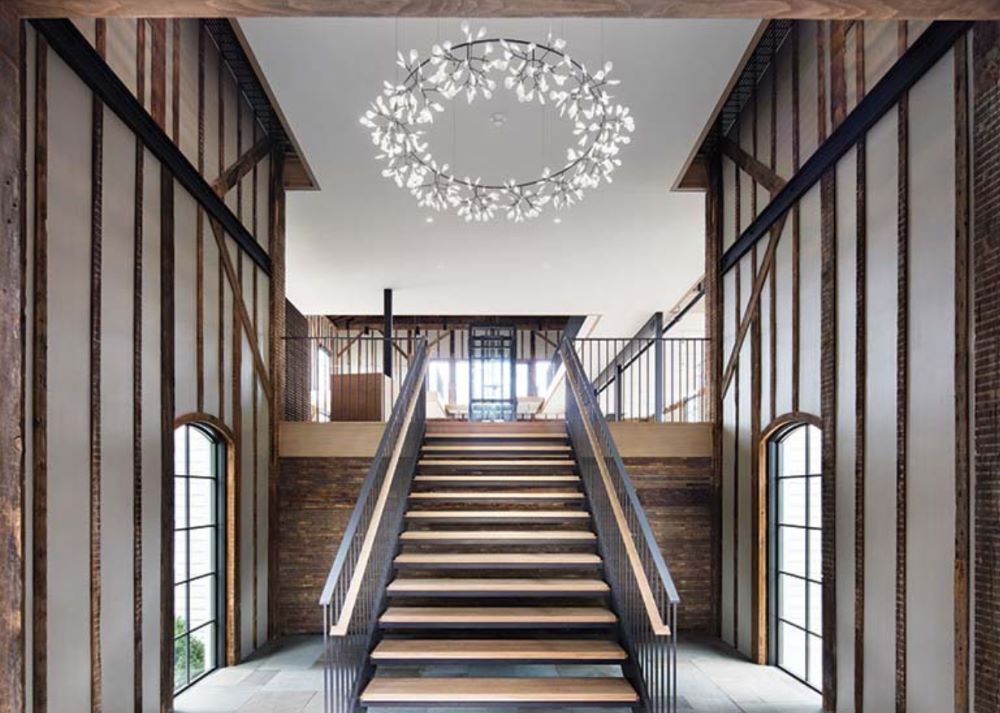
Access to the Bell Tower (Photo Scott Francis)
Eric Fischl offered an artistic solution to the gigantic windows, which had once been filled with leaded glass. Instead Skolnick won permission from the town to replace wooden frames with aluminum, and Fischl contributed portraits of 20 notable creative types who had a relationship to the area, including Herman Melville, Langston Hughes, James Fenimore Cooper, George Balanchine, Spalding Gray and Betty Friedan. “The only people who can be immortalized,” Skolnick says, “you have to be dead.”

(Photo Scott Francis)
It was a lively panel. And then people were off to tour the houses
THE HOUSES

471 Hill Street, Southampton, owned by Quinn Pofahl. The house is on the market, for $6,995,000. You can see a designer’s controlled hand in the tasteful matching of colors and the setting of moods. Pofahl was the Senior Vice President of Design for Ralph Lauren Home, and worked for the brand for 20 years. His aesthetic in his own home reflects the same superb taste. Each room is balanced and restrained. You could not imagine one thing added, or taken away.
All photographs are from the Douglas Elliman listing.
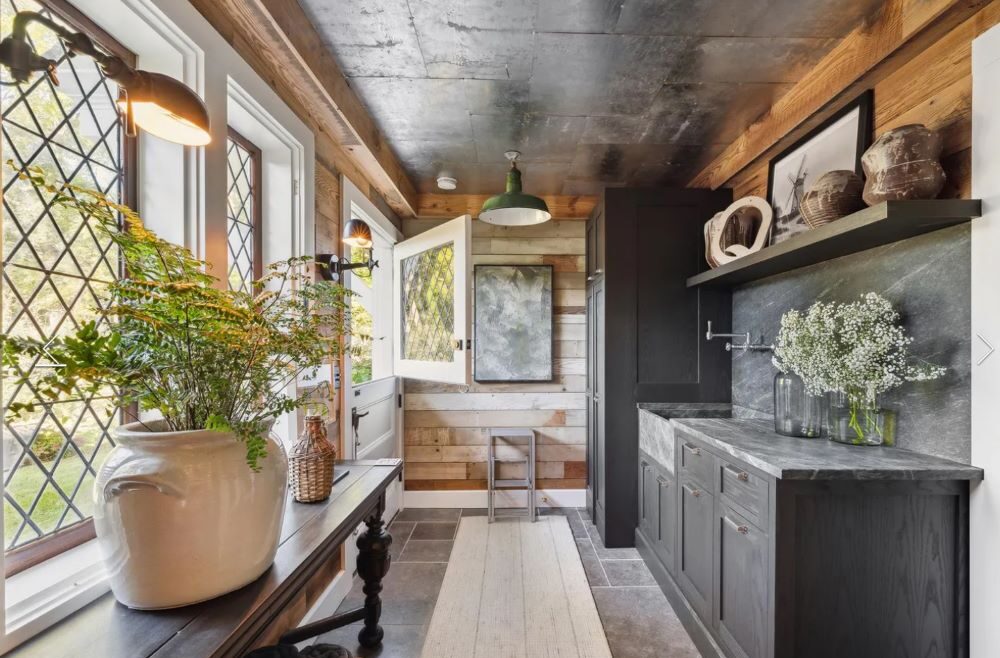
If this is meant to be a mud room, no one would dare track mud here. For one thing, nowhere to take off your boots. Maybe it’s a potting room. It IS beautiful.
The house was built in 1910 as an artist’s studio. Thus the main part is one long room. A two-year renovation divided that room in two with a pair of cleverly placed screens. The kitchen of course was completely redone. You will note that the colors in the cabinetry above and below seem chosen from the same can of Farrow & Ball Bible Black.
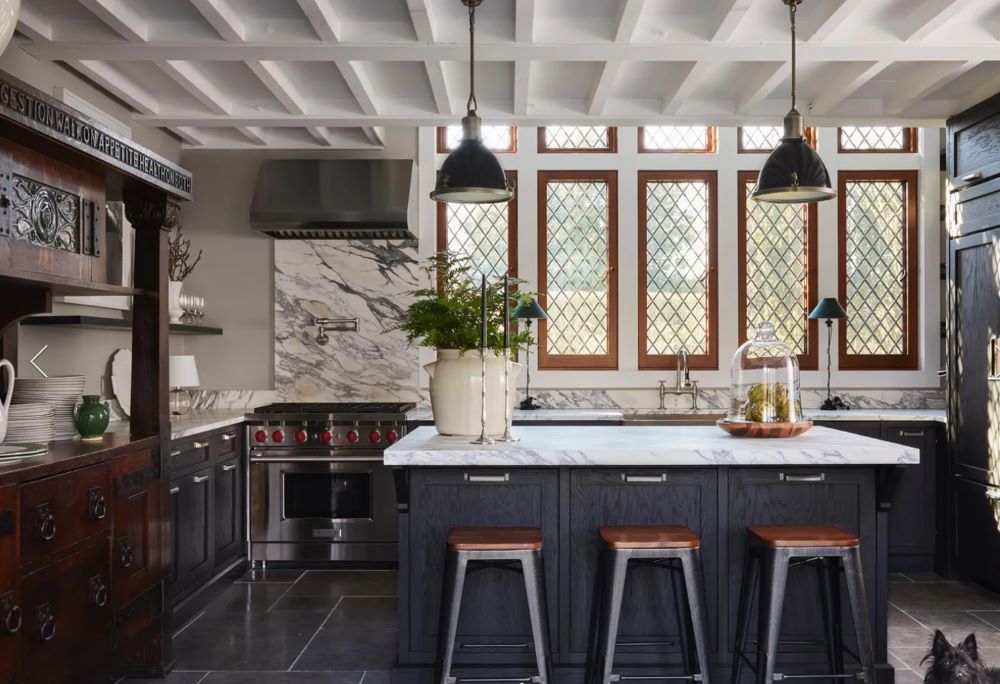
The pot-filling spigot over the range is nice. The rhythm of the kitchen seems natural. Is it possible to have too many windows in the kitchen?
Just off the dining room is a sunken lounge with a wet bar. It is so inviting, it might be hard to get people to leave.
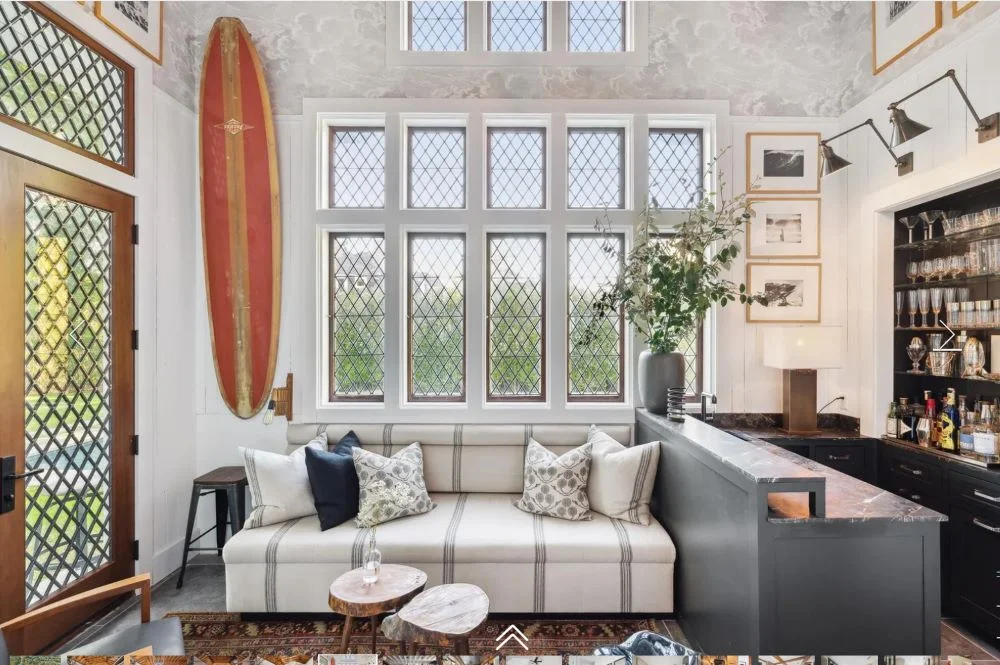
The cozy sunken lounge with wet bar.
And here is the dining room, one-half of the long room that made up the original studio.
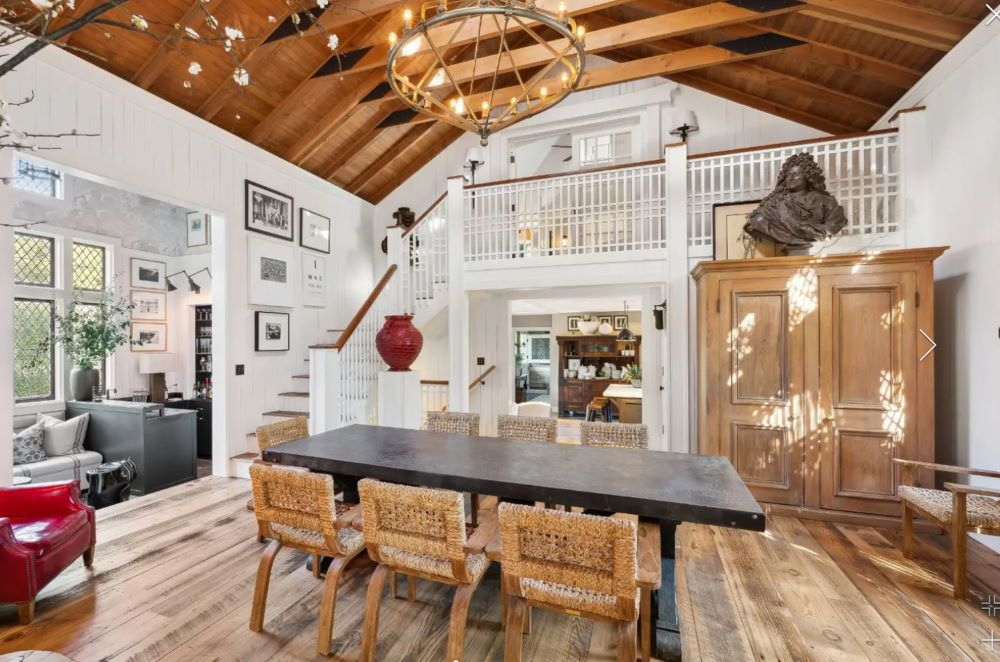
Note that few colors insert themselves into the basics of wood, natural fibers, a gray table and white walls. A bust, a clay pot, and a squat red arm chair offer spare color. It is up to people, table settings, flowers and food to add color to the scene.
SOUTH MAIN STREET
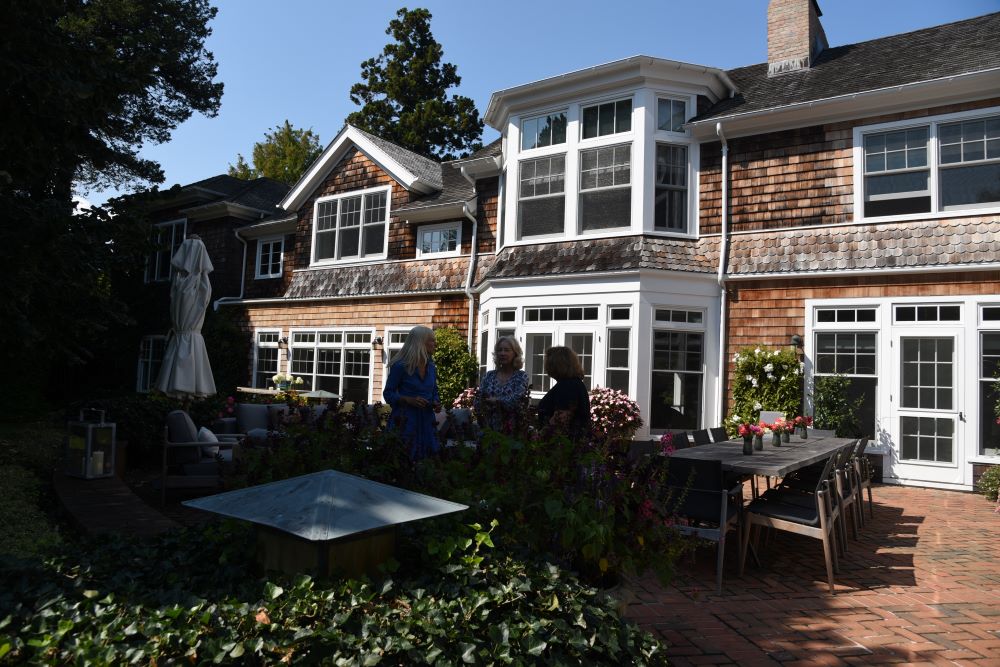
A shingled house on South Main Street, Southampton (Photo S. Eichner for Rob Rich/SocietyAllure.com)
Sometimes it takes just a few small touches to make a house feel contemporary. Bathrooms and kitchens are most likely to be updated, and therefore the most likely to have a new look. A sense of humor is always welcome in the toilet, from wallpaper to a vintage bathing costume. Remember playing tennis with a wooden racquet?

(Photo S. Eichner for Rob Rich/SocietyAllure.com)
Antique wooden horses aren’t modern. Posing them together, like this, is. It also solves a problem: blocking access to a patio door. Note that right-handed people usually draw and post animals facing left.
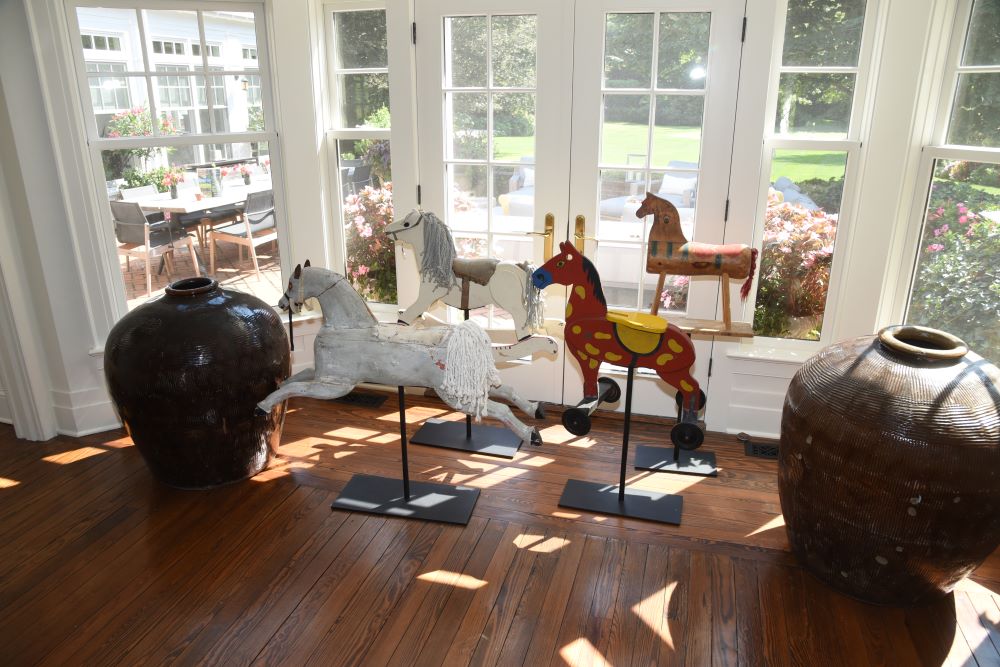
(Photo S. Eichner for Rob Rich/SocietyAllure.com)
In this house, there were collections galore, used to add a surprise at various locations. That was especially true on top of an antique apothecary’s cabinet, where the heads seemed to be giving visitors the side-eye.

(Photo S. Eichner for Rob Rich/SocietyAllure.com)
34 POST CROSSING ROAD, SOUTHAMPTON

Jim Karas and Brian Brady (Photo S. Eichner for Rob Rich/SocietyAllure.com)
Brian Brady has a distinguished career as a classical architect, having studied at the University of Notre Dame, and worked on projects around the world for I.M. Pei Partners. He is a member of the Institute of Classical Art & Architecture and the founder of Brady Design in Southampton. His home at 34 Post Crossing Road, is a classic Southampton beauty. But there are rooms in it that look so pared down they could have been designed by John Pawson.
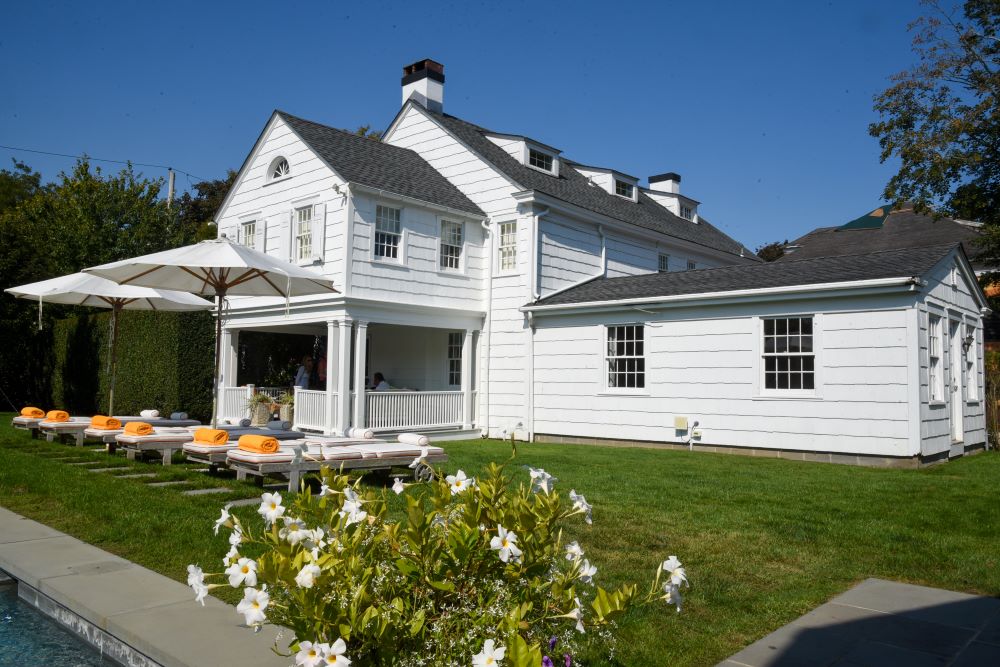
The pool side of the house (Photo S. Eichner for Rob Rich/SocietyAllure.com)
The house is large, but old. And sometimes that means low ceiling, small windows and small rooms. Too many details can make a room in a house like that feel cluttered. Frank Lloyd Wright said, “Less is more only when more is too much.” In this case, Brady went for less.
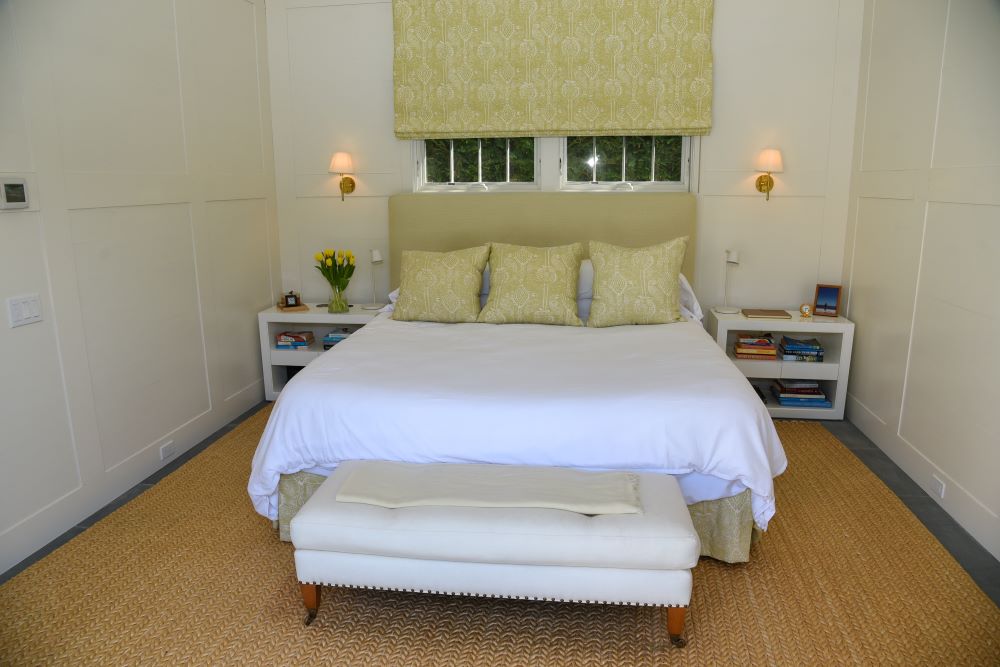
(Photo S. Eichner for Rob Rich/SocietyAllure.com)
If you put one more thing in that bedroom, it would be too much. Even art on the wall would clutter the room. It needs to be simple. Design fetishists can enjoy the hammered upholstery tacks on the footboard bench. The practical braided jute or sisal rug means wet feet can come and go in the summer. It’s a no stress room, just as it would have been 100 years ago, except they didn’t have Roman shades back then.

Once a classicist, always a classicist (Photo S. Eichner for Rob Rich/SocietyAllure.com)
With his background, Brady obviously could not help but match two Empire chairs on either side of an antique console table, and put two matching lamps in front of an antique, de-silvered mirror.
But look! There is a Brancusi-like stone sculpture, and a rather rough-looking stone circle. Those modern touches keep this from being Classical, with a capital C. (That would have required a bust of Mozart, or Napoleon.)
28 Bowden Square, Southampton
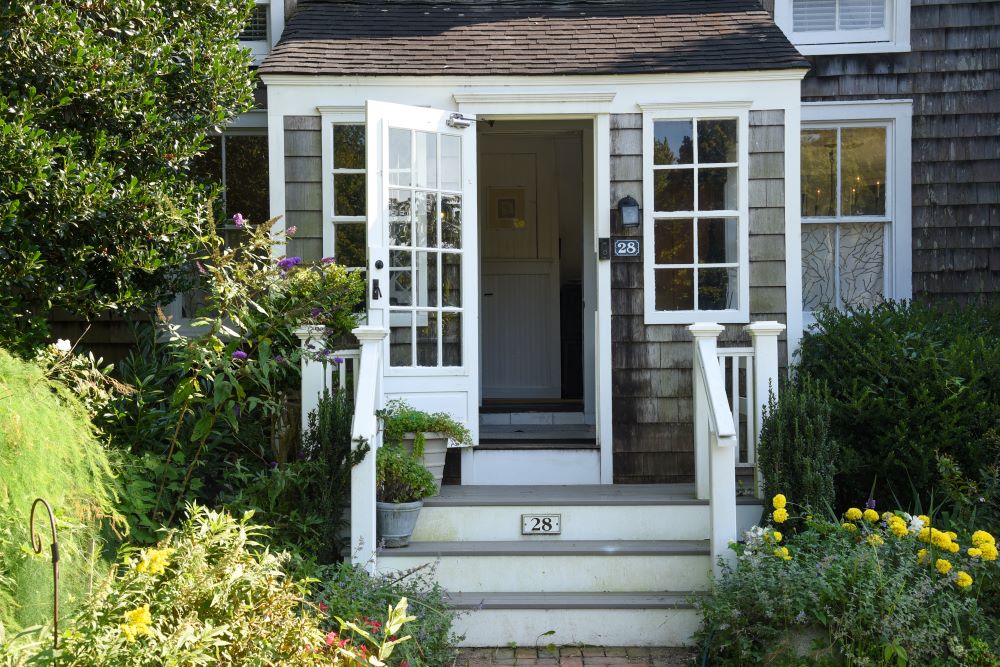
(Photo S. Eichner for Rob Rich/SocietyAllure.com)
The shingled house at 28 Bowden Square held a surprise. Here was a dining room with a built-in corner cupboard. And there were six mustard-colored Eames molded fiberglass armchairs with zinc Eiffel bases.

You can’t get more midcentury modern than that. Those Eames molded chairs seemed as happy to be there as the yellow marigolds that were blooming outside her front door. It was such a treat to see them there. Especially with the cobalt blue bowl she put on the table for contrast. There was all kinds of modern art at 28 Bowden Square, in every room. I even found some in the garage, possibly waiting for framing.

Robert Lohman with three prints of Justin Timberlake’s mug shot. (Photo S. Eichner for Rob Rich/SocietyAllure.com)
Those prints are called “Tuesday Night Out Featuring Justin Timberlake,” and they are the brainchild of two people, the artist Mary Godfrey and the photographer Robert Lohman. Together for this piece of art they called themselves “Godfrey Lohman.” They gave Timberlake’s mugshot the Warhol treatment in four color combinations and sold them in a Sag Harbor gallery across the street from the American Hotel. The price was $520 for the numbered prints, each in an edition of 60. No wonder Robert Lohman looks so pleased with himself.
I saw only three prints in the garage, but there could have been a fourth one hiding behind some boxes. Bravo!
Some people know how to knock the socks off an old home. The panel discussion, followed by the house tour, taught me a few lessons I want to take home to Sutton Place.



